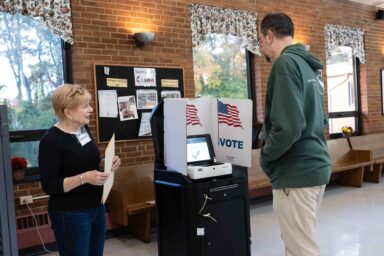Schools are rated on all kinds of factors. This year, WhoWhatWhy ranked them in terms of student voter turnout and accessibility. Months of research boiled down to the top schools in every state, whether they make it easy for their students to vote.
|
Listen To This Story
|
Students across the country are gearing up to vote, just as the pandemic weighs down on their options. Universities and colleges are graded on all sorts of factors, from academics to party statistics, but what about voting? How accessible is voting on school campuses? From registering to voter ID and everything in between, WhoWhatWhy ranked the nation’s largest and otherwise top-rated campuses to show how easy or hard it is to cast that ballot.
Despite having the potential to shape elections with their size as a cohort, youth have historically turned up to vote at lower levels than older adults. Barriers to the youth vote include proof of residency and identification requirements, missing class or work to wait in line, and finding transportation to off-campus polls. Given the prominent role that colleges and universities play in the lives of new voters across the country, it is crucial to analyze what they are doing to encourage democratic citizenship.
This guide provides key data points, including the number of polling places on campus, student voting rates, and the number of polling stations within five miles of campus.
The 76 schools included in this analysis rank in terms of formal democratic participation and can use this guide to prioritize ways to facilitate and improve campus engagement.
The Student Voter Guide also advises prospective students on university voter policies, informs and encourages current students to vote, and it recognizes universities that facilitate accessible and student-friendly on-campus voting.
Number of On-Campus Polls vs. Student Voter Turnout
On-campus polls help remove barriers to student voting, such as finding transportation to off-campus polling locations.
During the 2016 General Election cycle, most schools with a 48-67 percent student voter turnout rate had one on-campus polling location. While some schools with two or more on-campus locations saw a higher turnout, overall results demonstrate that having more polling stations does not guarantee a higher voter turnout. That said, increasing the number of campus polling stations can have other benefits, such as reducing wait times and the number of students who miss class to cast their ballot.
Number of Campus Residents vs. Student Voter Turnout
Students living on campus often have an easier time voting since their proof of residency is issued by the university, and on-campus polling locations are determined, in part, by their proximity to dorms and residential dwellings.
Schools with a greater number of students living on campus see higher voter turnout rates during presidential elections. Given that 73 percent of schools analyzed had at least one on-campus polling station during the 2016 general election, this finding suggests that a large percentage of college students across the country rely on on-campus voting options.
On-campus Polls vs. 2016 State Political Outcomes
Since decisions to allocate on-campus polling places reside with state governments, it is necessary to analyze whether partisanship influences student-friendly voting options.
While 48 percent of schools with on-campus polls voted Democrat in the 2016 election, 60 percent of schools without on-campus polls voted Republican. Beyond reflecting President Trump’s victory in the electoral college, the fact that Republicans lead the study in schools both with and without on-campus polls is largely attributable to the data set.
Of the five states that hold elections entirely by mail, only Utah voted Republican. This fact is unsurprising, given that in recent years Colorado, Hawaii, Oregon, and Washington have favored democratic leadership in presidential elections.
Ranked Scorecard
Schools are ranked according to formal civic engagement. In contrast to informal political participation, including protesting, activism, and service-oriented work, formal participation involves voting, political party membership, and working on a campaign. Both forms of participation are essential for democracy to thrive.
However, for fair measurement and concrete comparison, schools were ranked based on the following:
- Percentage of student voter turnout
- Percentage of early student voter turnout
- Number of on-campus polling places
- Voter registration drives
- Voter registration rate
- Student ID accepted as voter ID
- ID requirements
- Photo vs. no photo
The grade reflects a range, based on the school’s rank. Schools are grouped based on similar characteristics, such as percent voter turnout, percent of students registered to vote, and voter ID laws.
It should be noted that these statistics are reflective of the 2016 general election and do not address any changes due to the COVID-19 pandemic.
WhoWhatWhy embodies a form of investigative reporting that is rigorous, relentless, and scientific.
Election integrity is at the heart of our democracy. Without it, our country won’t run the way the founders intended — the way we deserve it to. In our EI coverage, we look deeply at the issues facing voters today and determine how we got here: from gerrymandered districts to voter registration purges to voter ID laws and everything in between. We are working to protect your vote from start to finish and knowledge is power.
As a nonprofit organization, we need readers, supporters, and citizens passionate about and committed to strong investigative journalism. Please consider a donation to support our efforts.




